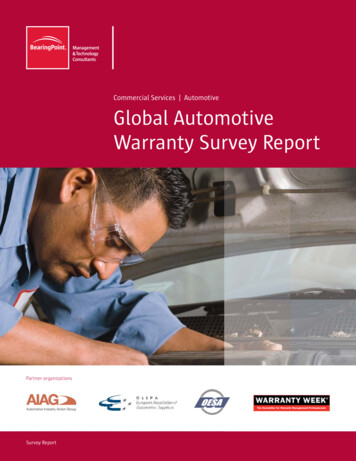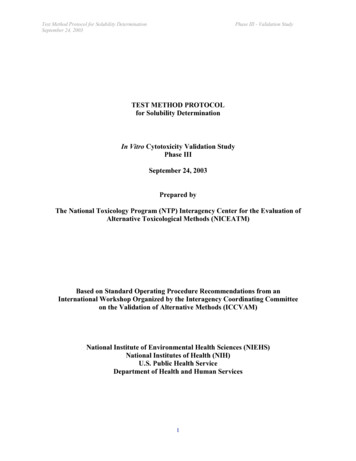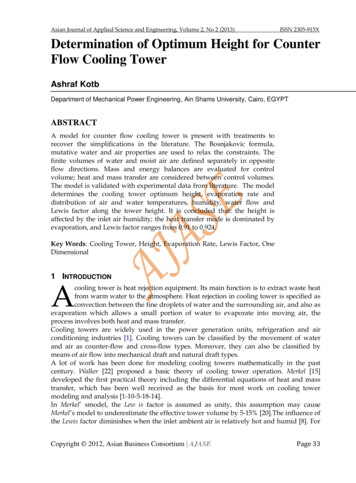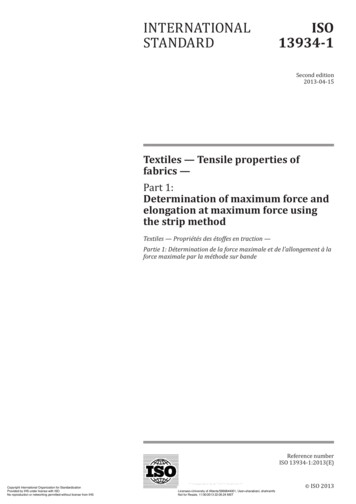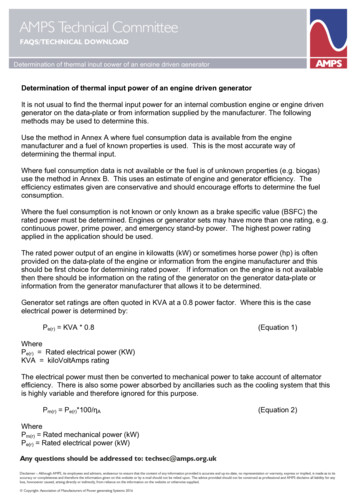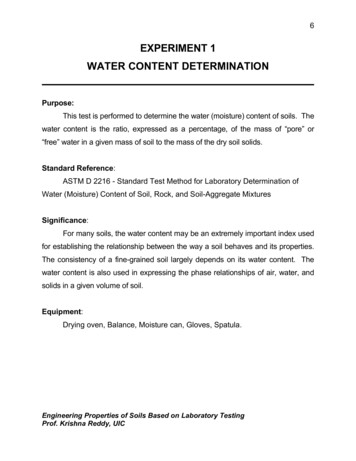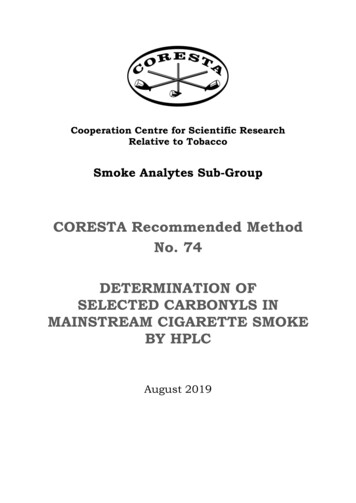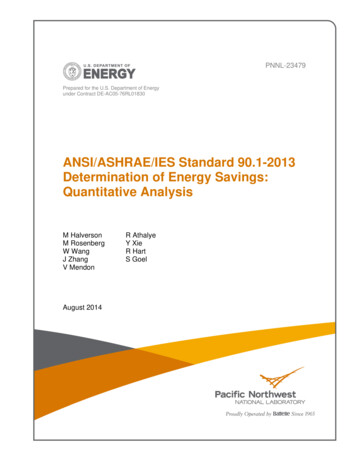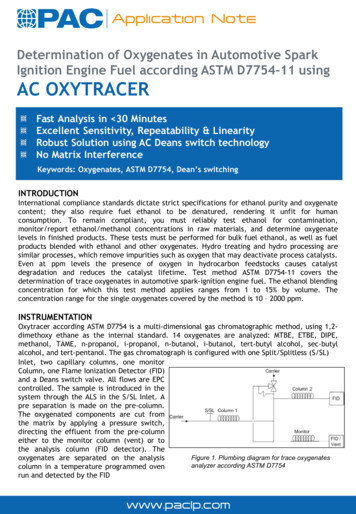
Transcription
Application NoteDetermination of Oxygenates in Automotive SparkIgnition Engine Fuel according ASTM D7754-11 usingAC OXYTRACERFast Analysis in 30 MinutesExcellent Sensitivity, Repeatability & LinearityRobust Solution using AC Deans switch technologyNo Matrix InterferenceKeywords: Oxygenates, ASTM D7754, Dean’s switchingINTRODUCTIONInternational compliance standards dictate strict specifications for ethanol purity and oxygenatecontent; they also require fuel ethanol to be denatured, rendering it unfit for humanconsumption. To remain compliant, you must reliably test ethanol for contamination,monitor/report ethanol/methanol concentrations in raw materials, and determine oxygenatelevels in finished products. These tests must be performed for bulk fuel ethanol, as well as fuelproducts blended with ethanol and other oxygenates. Hydro treating and hydro processing aresimilar processes, which remove impurities such as oxygen that may deactivate process catalysts.Even at ppm levels the presence of oxygen in hydrocarbon feedstocks causes catalystdegradation and reduces the catalyst lifetime. Test method ASTM D7754-11 covers thedetermination of trace oxygenates in automotive spark-ignition engine fuel. The ethanol blendingconcentration for which this test method applies ranges from 1 to 15% by volume. Theconcentration range for the single oxygenates covered by the method is 10 – 2000 ppm.INSTRUMENTATIONOxytracer according ASTM D7754 is a multi-dimensional gas chromatographic method, using 1,2dimethoxy ethane as the internal standard. 14 oxygenates are analyzed: MTBE, ETBE, DIPE,methanol, TAME, n-propanol, i-propanol, n-butanol, i-butanol, tert-butyl alcohol, sec-butylalcohol, and tert-pentanol. The gas chromatograph is configured with one Split/Splitless (S/SL)Inlet, two capillary columns, one monitorColumn, one Flame Ionization Detector (FID)and a Deans switch valve. All flows are EPCcontrolled. The sample is introduced in thesystem through the ALS in the S/SL Inlet. Apre separation is made on the pre-column.The oxygenated components are cut fromthe matrix by applying a pressure switch,directing the effluent from the pre-columneither to the monitor column (vent) or tothe analysis column (FID detector). TheFigure 1. Plumbing diagram for trace oxygenatesoxygenates are separated on the analysisanalyzer according ASTM D7754column in a temperature programmed ovenrun and detected by the FIDwww.paclp.com
Application NotePRECOLUMN ANALYSISThe sample is injected onto a methyl siliconepre-column which elutes lighter hydrocarbons toa monitor column and retains the oxygenatedand heavier hydrocarbons. Just before methanolelutes from this column, the valve and thus aPCM pressure is switched and the componentscoming from the pre-column are directed to theanalysis column. After TAME has eluted fromthe pre-column to the analysis column, thevalve is switched back to its original position,switching the pressure again.All the other components remaining on the precolumn are now directed to the monitor columnand the vent. The oxygenated components arenow separated from the remaining hydrocarbonson the analysis column and are detected by theFlame Ionization Detector.According to the ASTM D7754-11 method, a 300 ppm solution without ethanol or internalstandard should be injected on the pre-columnonly (figure 2). From this chromatogram theoxygenate transfer valve time can bedetermined.Figure 2. 200 ppm Precolumn mix - OxygenateElution Pattern from precolumn only.VALIDATIONThe system and methodology of the Trace Oxygenates analyzer are thoroughly tested forseparation efficiency, repeatability, response linearity, recovery and detection levels.SEPARATION EFFICIENCYChromatographic conditions should be optimized to obtain complete separation of the first threeeluting peaks (ETBE, MTBE and DIPE). Maximum resolution of these peaks is critical for accuratequantification of each individual component.REPEATABILITYArea and retention time are the two primary measurements in gas chromatography. Theprecision in which they are measured ultimately determines the validity of the generatedquantitative data. Retention time and area precision require that all parameters (temperatures,pressure, flow, injection) are controlled to exacting tolerances. Furthermore, the inertness ofthe flow path can considerably affect area precision, especially for active components at lowlevels.Area and retention time repeatability for the AC Oxygenates analyzer according ASTM D7754-11are measured for 10 consecutive runs (table 1) for a standard blend containing approximately 50ppm per component. Very good repeatability values are obtained.www.paclp.com
Application NoteFigure 3. Separation efficiency of 100 ppm standard blend2-Butanol &N-propanoli-Butanol && 0.24%0.89%0.26%0.28%0.46%0.24%Table 1. Area Repeatability for 50 ppm standard blend (n 10), corrected for Internal Standard areawww.paclp.com
Application NoteLINEARITYThe linearity of response for the analyzer is verified by analyzing 6 different calibration mixturesin a range of concentration covering the scope of ASTM D7754-11. The set of oxygenatecalibration standards consists of 10, 50, 100, 250, 500 and 1000 ppm (m/m). The standardsassume ethanol is present in the streams to be analyzed in percent levels, so the calibration forethanol consists of 1.0, 2.5, 5.0, 7.5, 10 and 15% (m/m). For each component the linearity plotsare created (see example figures below). All calibration lines have a linearity correlation 0.999.Figure 4: Linearity Plot MethanolFigure 5: Linearity Plot ETBEFigure 6: Linearity Plot t-PentanolQC REFERENCE MATERIALAfter the calibration has been completed, two quality control check standard referencematerials have been analyzed. The two check standards are prepared by diluting an oxygenatestock solution and ethanol in in an oxygenate free automotive spark-ignition fuel sample.One concentration of the QC reference material is prepared in the lower range (circa 30 ppm)and another in the upper concentration range (500 ppm). The reference material is analyzed as anormal sample. According the method, the oxygenate concentration values obtained shouldagree within 15 % for the lower range, and 5 % relative for the higher 32.0**30.1* Coelution SUM59.760.20.8%** Coelution *n-Butanols-Butanol**tert-Pentanol* CoelutionSUM** CoelutionSUMTable 2. Recovery Calculation low range QC 5%**-0.4%Table 3. Recovery calculation high range QC Samplewww.paclp.com
Application NoteFigure 7: Chromatogram of 30 ppm QC reference material.VERIFICATION OF DETECTABILITYTo verify the detectability of the system, a 5 ppm (m/m) calibration solution should be injected,and ensured that a signal/noise level of at least 5 is observed.DETECTABILITYFigure 8 shows the signal to Noise verification of the 5 ppm Oxygenates / 1.0 % Ethanol checkstandard. It clearly show the signal to noise ratio is 5 for all oxygenates.Figure 8: Chromatogram of 5 ppm QC check sample to calculate detectivity.5www.paclp.com
Application NoteCONCLUSIONThe AC Trace oxygenates analyzer is a dedicated solution for determination of traces Oxygenates inAutomotive Spark Ignition Engine Fuel by Deans Switch Gas Chromatography. Its performance notonly meets but exceeds ASTM D7754-11, ensuring the best quality data that can be used to estimateoxygenates in downstream processes or car engine management.The application of a FID detector, well known for its stability and ruggedness, in combination withthe proprietary AC Deans Switch Technology makes AC Oxytracer very robust and easy to use inroutine environments. Because the analysis column is free of interfering components, AC Oxytracerprovides unambiguous identification and accurate quantitation every time. The hydrocarbon matrixis vented for the fastest run to run cycle time of under 30 minutes to guarantee the highest possiblesample throughput.AC Analytical Controls has been the recognized leader in chromatography analyzers for gas, naphtha and gasoline streams incrude oil refining since 1981. AC also provides technology for residuals analysis for the hydrocarbon processing industry.Applications cover the entire spectrum of petroleum, petrochemical and refinery, gas and natural gas analysis; ACs Turn-KeyApplication solutions include the AC Reformulyzer , DHA, SimDis, NGA, Hi-Speed RGA and Customized instruments.00.00.xxx - Copyright 2016 PAC L.P. All rights reservedwww.paclp.com
in a range of concentration covering the scope of ASTM D7754-11. The set of oxygenate calibration standards consists of 10, 50, 100, 250, 500 and 1000 ppm (m/m). The standards assume ethanol is present in the streams to be analyzed in percent levels, so the calibration for ethanol consists of 1.0, 2.5, 5.0, 7.5, 10 and 15% (m/m). For each component the linearity plots are created (see example .

